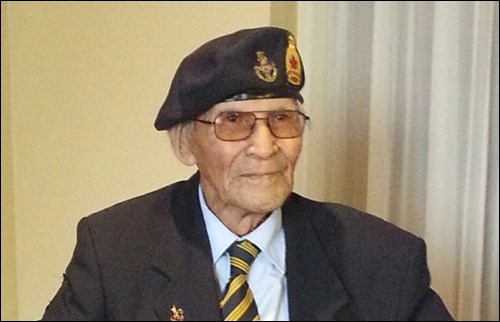A renowned local artist and veteran of the Second World War has passed away.
Henry Beaudry, who was born on Poundmaker First Nation and who lived on Mosquito and Sweetgrass First Nations, died this week at age 95.
Beaudry will be remembered for his service to the country and as a POW survivor, as well as for his many and wide-ranging works of art.
Beaudry’s works have been shown in galleries across western Canada, including a major display at Wanuskewin as well at the Allen Sapp Gallery, the Museum of Natural History in Regina and other venues. Battleford Furniture has displayed many of Beaudry’s works at its location.
He was born Henry Poundmaker Beaudry in 1921, a great-grandson of the legendary Chief Poundmaker.
His friend, artist Darwin Atcheynum, said big things were predicted for Beaudry right from an early age. An old man, the story goes, pointed out Beaudry in a group of kids and said “this guy’s going to travel all over the world, he’s going to see a lot of stuff, a lot of tough things.”
“Sure enough,” Atcheynum said, “he went through his life doing everything that old man said.”
Beaudry is remembered for his combat exploits in the Second World War, as well as his prolific work as an artist.
He joined the armed forces after seeing a poster during a visit to Paynton. The poster read: “Join the Army and see the world, and kiss the girls in every port.”
At age 19, he enlisted and eventually was posted to Italy.
During his tour of duty in Italy Beaudry was wounded, forcing a lengthy hospital stay. He was later captured in Ravenna, Italy by the Nazis.
Beaudry was taken prisoner and sent to the infamous Stalag VII-A, the largest German prisoner of war camp during the Second World War.
But in the course of being moved to another location, Beaudry escaped, along with a fellow Mongolian prisoner from the Russian army. After days walking in cold conditions, Beaudry was taken in by a group of farmers who hid prisoners from the German army.
Beaudry eventually wound up in Holland. As the war wound down, Beaudry was taken in by the American forces and fought alongside them.
“The Great Spirit guided me all the way,” said Beaudry in an interview with the News-Optimist earlier this year.
After the war, Beaudry took up art on Mosquito First Nation, starting out doing drawings on paper but eventually moving into paintings.
The war years would be well represented by Beaudry in his artwork later on. One of his works depicts prisoners entering the Stalag VII-A prison camp. Another memorable work depicts him standing before German soldiers while being interrogated.
Beaudry signed each one of his paintings with a drawing of an eagle feather, a reference to the eagle feather he had kept with him during the war, but which he lost on the day he was captured.
Beaudry earned a living as an artist and his work eventually came to the attention of Chris Odishaw of Battleford Furniture, who developed a strong friendship with Beaudry.
He met Beaudry for the first time back in 1979 when his parents first opened their furniture store and ultimately struck a deal with Beaudry where the artist would do paintings for him exclusively. Odishaw today owns a collection of Beaudry’s work numbered at around 1,300.
In an interview with the News-Optimistearlier this year, Odishaw noted Beaudry’s prolific style of painting. His works included “a lot of early days, the early prairie days with the horses and the wagons and the firewood,” said Odishaw. And there were several that were war-related.
Beaudry was entirely a self-taught artist. His style has much in common with his contemporary, the late Allen Sapp, in that he painted “out of his mind and out of his memory,” Odishaw said.
Beaudry’s artwork made its way to the famous and powerful, with works presented to Queen Elizabeth and to Pierre Elliott Trudeau. He met Justin Trudeau in Saskatoon in 2013, when the future prime minister was in the city for the Canada Remembers Our Heroes Air Show.
A documentary on Beaudry’s life, entitled H. Beaudry: Covers the Earth Boy, has aired on outlets such as CTV, APTN and others in recent months.
Until the end, Beaudry continued to live independently on Sweetgrass First Nation although he did move into Villa Pascal for the winter months.
Plans are for Beaudry to be buried at Mosquito First Nation.

.png;w=120;h=80;mode=crop)

.png;w=120;h=80;mode=crop)
